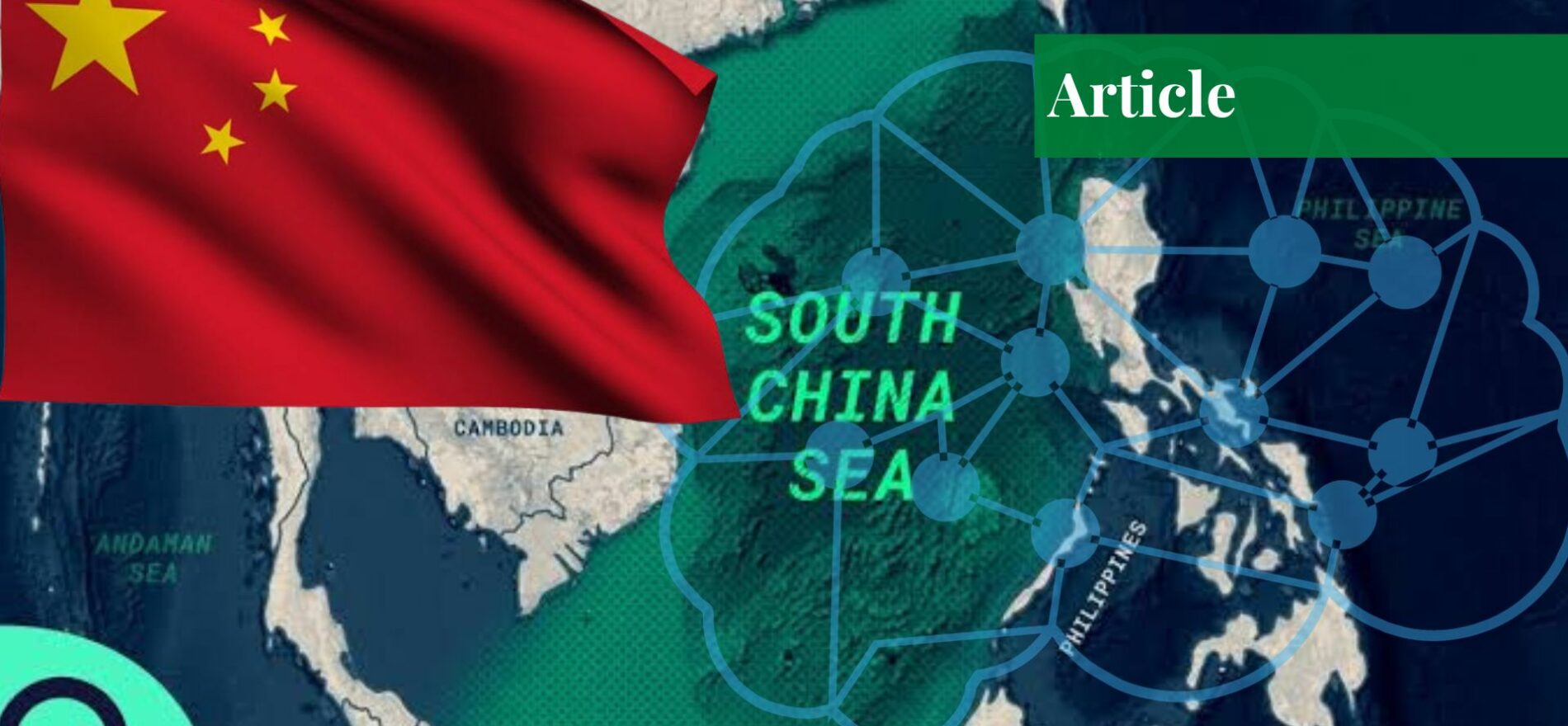Ms. Amina Iqbal is studying international relations at Kinnaird College for Women University, Lahore.
Introduction
The South China Sea holds great geopolitical and economic importance due to its pivotal maritime trade routes, abundant fisheries, and enormous reserves of oil and gas. China’s use of artificial intelligence (AI) in the region is an intelligent attempt to strengthen its control and marine might. Moreover, the use of artificial intelligence makes it possible to develop complex autonomous underwater systems and implement real-time monitoring, to strengthen China’s naval presence and strategic advantage in the contested South China Sea.
Furthermore, China wants to safeguard its interests, acquire a technological advantage, and exert dominance in this important geopolitical field, placing itself as a vital participant in regional affairs. However, to do this, China is integrating AI into deep-sea operations, marine drones, and decision-making processes.
China’s Strategic Utilization of AI in the South China Sea
In the South China Sea, the use of artificial intelligence is at its peak because the world has transformed, and every state wants to expand its influence in the region; therefore, they’re utilizing AI for this purpose. However, China is leveraging AI as a key advantage in the region, intending to enhance its control and influence in the region via different applications.
Deep Sea Operations
China is planning to develop an AI-run colony deeply focused on unmanned submarine science and defense operations. The proposed colony, potentially situated in the Manilla Trench, justifies China’s deployment of valuable resources in the South China Sea. Moreover, this location makes it easier to observe seismic activity and may even make it possible to conduct hostile activities as well as follow foreign vessels while masking them as humanitarian goals.
Maritime Drones
The Chinese Academy of Sciences is pursuing an ambitious plan to develop Extra-large Underwater Unmanned Vehicles (XLUUVs) and unmanned autonomous underwater submarines. There are numerous advantages of these drones as they can travel great distances and perform a variety of tasks, raising serious security problems such as the possibility of unintentional assaults or plausible denial of intentional activities.
Underwater Great Wall
In the South China Sea, the “Underwater Great Wall” initiative of China involves deploying a network of submarine detectors to enhance national security. In addition, by placing subsurface sensors around the region and enabling real-time monitoring this strategic initiative seeks to offset the advantage enjoyed by the United States and Russia in submarine capabilities.
Dual-Use Technology
China is investigating how to improve military applications particularly in naval operations by integrating AI algorithms from the civilian sector. Additionally, the ability of artificial intelligence to significantly enhance military capabilities is demonstrated by the seamless transition of AI algorithms from civilian use, for instance, controlling unmanned submarines.
China’s Island Building in the South China Sea
In recent times, China developed an AI model for its island-building projects in the disputed South China Sea (SCS). The Transportation Science and Engineering College of the Civil Aviation University of China, Tianjin has created this AI simulation to support China’s maritime claims in this divisive area. Moreover, the simulation envisions a logistics network connecting 17 to 80 features in the Spratly and Paracel Islands, fostering business growth and bolstering China’s influence.
However, the most comprehensive scenario with 80 elements would require an estimated expenditure of 20 billion yuan, about US $2.9 billion, which will include the cost of docks, warehouses, cargo ships as well as regular flights in the simulated logistics network. Furthermore, by strengthening its influence and maritime activities in the region, China may increase its commitment to improve its logistical capabilities which would exacerbate the already tense geopolitical dynamics in the region.
Implications
The use of artificial intelligence in the South China Sea has numerous implications and some of them are following.
Geopolitical and Security Implications
The South China Sea’s AI integration by China has significant geopolitical and security implications. The AI technologies enhance China’s maritime surveillance, reconnaissance and military capabilities, allowing for real-time monitoring and analysis of regional activity. The strategic positioning and response capabilities of China in the contentious territories are improved by its increased situational awareness, potentially shifting the balance of power and affecting local geopolitical dynamics. Likewise, the militarization of AI can increase security concerns and exacerbate regional conflicts, possibly sparking competition to develop the most advanced and complex AI systems.
Privacy and International Law Concerns
China’s extensive use of artificial intelligence in the South China Sea creates privacy issues and concerns regarding international law compliance. In addition, AI’s monitoring powers, mainly in the marine sector, may violate neighboring states’ privacy and sovereignty. Concerns have been raised about privacy as well as transparency about the gathering and analysis of data about naval and civilian activities.
Furthermore, a framework is needed that ensures the appropriate and legal deployment of AI in the region because, in contemporary times, there are no clear global agreements or rules addressing the use of AI in maritime security, leaving the possibility for ambiguity and potential abuse.
US Response to China’s Strategic Claims in the South China Sea
Many observers believe that current US responses to China’s operations in the South China Sea are insufficient. This weak response has unintentionally contributed to the myth that China is progressively driving the United States out of the region. In the view of the regional states, it has evolved into a key test of American commitment. The United States loses some of its appeal as a dependable security partner if it cannot successfully oppose Chinese coercion and runs the risk of sending a harmful message about the strength of its alliance structure.
The US has had difficulty adequately assisting its regional partners in resisting Chinese coercion. While these partners must maintain strategic autonomy, capacity-building efforts have struggled to keep up with China’s rapidly developing capabilities. Furthermore, upholding international law in the South China Sea remains difficult. To effectively resist China’s control ambitions, the United States must consider non-military solutions and strive to develop a larger coalition of regional partners.
Strategic Approach & Alliance Leverage
The United States requires a long-term and diverse strategy to properly fight China’s aspirations to control the South China Sea. Maintaining a strong regional position requires the country to preserve its military advantage. This includes investing in critical capabilities while emphasizing military presence in the Asia-Pacific region. Furthermore, leveraging strong Asian allies is critical to raising the costs of Chinese efforts to undermine the regional system. The United States should push close allies like Australia and Japan to contribute significantly, strengthening capability and capacity for a cohesive and effective response to Chinese coercion.
Conclusion
To sum up, China’s strategic integration of artificial intelligence into its naval operations in the South China Sea demonstrates a carefully planned move aimed at enhancing its influence and control over a region of extensive geopolitical and economic significance. Additionally, China aims to gain an important strategic advantage by adopting AI technologies for deep-sea operations, autonomous underwater vehicles, submarine detection networks and even island-building simulations.
However, this will foster increased surveillance capabilities and strengthen its military power in the disputed waters. Nevertheless, this militarization fueled by AI raises concerns around the world from potential violations of international standards and privacy issues to shifts in geopolitical power. To maintain peace and stability in the region and elsewhere, it is crucial for the global community to watch and negotiate the changing landscape of AI applications carefully. Thus, this requires striking a balance between technological innovation and adherence to ethical, legal, and privacy standards.
If you want to submit your articles, research papers, and book reviews, please check the Submissions page.
The views and opinions expressed in this article/paper are the author’s own and do not necessarily reflect the editorial position of Paradigm Shift.



















